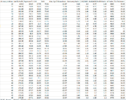- Joined
- 28 December 2013
- Posts
- 6,392
- Reactions
- 24,319
Note : I DO NOT expect to make a 2M profit on 100k in 5 years.
Backtesting means JACK
@qldfrog, well stated - without getting into another exchange, I want to re-stated that (IMHO), Amibroker backtest results mean "Jack" & hold little interest in assessing the true performance of a strategy. Live trading is the "true measure" as it confirms if your "trading plan" is solid.
Skate


